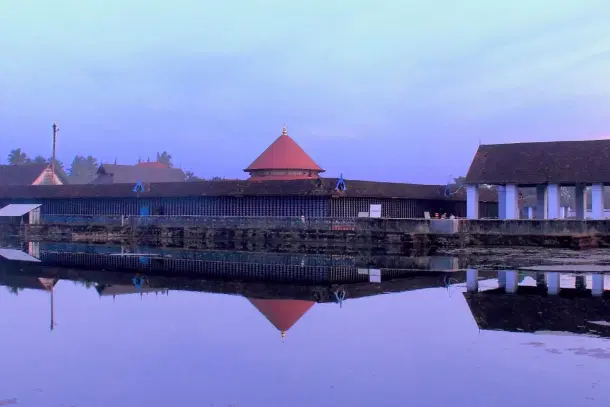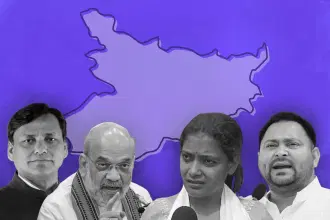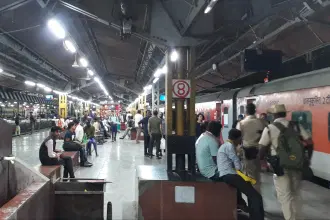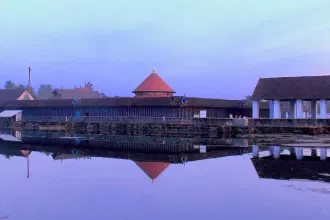Culture
Democracy Or Devalaya Dharma: Why A Garland Maker's Appointment In A Kerala Temple Has Left Hindus Divided
S Rajesh
Nov 03, 2025, 12:12 PM | Updated 12:12 PM IST
Save & read from anywhere!
Bookmark stories for easy access on any device or the Swarajya app.


Tucked away in Irinjalakuda, Kerala, serene, symmetrical, and steeped in sanctity, is the Koodalmanikyam temple, dedicated to Bharata, the lesser-worshipped brother of Lord Rama.
As the second shrine in the sacred Nalambalam circuit, a set of four temples representing Lord Rama and his brothers, traditionally visited in a single day, it marks a quiet, contemplative pause in the pilgrims’ journey to honour them.
The tranquillity that defines Koodalmanikyam has, however, lately been stirred, not by temple drums or festival crowds, but by a debate over who may make the garlands that adorn its deity. The job, traditionally done by three families belonging to the Warrier (also spelt as Varier) community, is now under the spotlight due to allegations of caste-based discrimination against K. S. Anurag, the man appointed by the Devaswom Board.
Alleged Boycott and a Letter
While the Warriers are Ambalavasis, an upper caste considered to be between Brahmins and Nairs due to their history of carrying out supporting roles in temples, Anurag belongs to the Ezhava community, a large and politically vibrant OBC grouping known to be the backbone of the CPI(M).
According to media reports, five out of the six thantris, who are Brahmins, have stayed away from the temple and submitted a letter to the chairman saying that they should have been consulted before he was appointed.
With time, what was a temple-specific issue transformed into a discussion with individuals largely split into two camps, one arguing that all people should be allowed to serve in temples, and the other saying that temples are not the place for social justice or democracy. Few argued for a middle ground, saying that both sides should be respected.
But before we go further into the points made by each side, we must know what led to Anurag’s appointment, and how a role carried out by families having hereditary rights came to be filled by government recruitment.
Change Started in the 1980s
Until 1984, the duty was performed on a rotation basis by three families. While two families worked for five months each, the third one took care of the remaining two. Of them, only the one with the right to serve for two months continues to perform the duty, as those with five-month rights surrendered them during that year.
After they relinquished their rights, the board appointed a person from the Ambalavasi community on a temporary basis for 10 months in a year. This continued till 1995, when one such person was made permanent. He retired in 2020.
Since then, the position has been open for recruitment and before Anurag, the board had appointed Balu K. A., who had the highest marks in the rank list. It was after his resignation, allegedly due to objections and non-cooperation from the thantris, that Anurag, who was next on the list, got recommended for the job.
The appointment was challenged before the Kerala High Court by the Thekke Variam family, which has traditional rights for two months. The Court, however, refused to pass any orders and asked the petitioners to approach the civil court. Thus, Anurag’s appointment remains valid.
The Devalaya Dharma Argument
While legal proceedings in the matter remain pending, the trial, if you wish to call it so, has begun on social media. What started from an X post by economist Harsh Madhusudan Gupta, who quoted an article by The News Minute, has now seen multiple people weighing in on the issue. Gupta, known to be a vocal supporter of allowing people from all castes to become priests in Hindu temples, wrote that this was nothing but a case of caste-based discrimination.
The main counter to him was from Ashwin Sampatkumaran, a Bengaluru-based advocate, who runs Dakshin Vrindavan, a shelter for rescued cows. Making the case for something he describes as Devalaya Dharma, or rules specific to a certain temple, he said that temples are not a laboratory to carry out social justice experiments.
He said that the rights to make garlands lay with certain families trained in the temple’s tantric and agamic traditions. “There is an element of attachment to the deity that has evolved over generations. While from the outside it may look like a routine staffing decision, it is not so. This is a religious matter and just because of the Devaswom Board’s signature, nobody can develop that relationship overnight.”
Dismissing the charge of caste-based discrimination, Sampatkumaran wrote that even though he is a Brahmin (the caste to which the thantris belong), a garland made by him would not be accepted. “It is not about the caste, it is about the family. The problem is not with Anurag’s caste, it is with Anurag’s family,” he told this writer.
“In another temple, some other families may have the garland-making rights. If these Warrier families try to offer a garland there, it would not be accepted.”
Rarest of the Rare Temple: Where Even the Flowers to Be Offered Are Specified
To understand why Sampatkumaran and others insist on preserving these customs, it helps to see what makes Koodalmanikyam distinct from other temples.
Unlike neighbouring states, where most temples are under Hindu Religious and Charitable Endowments (HRCE) departments, Hindu shrines in Kerala are under the Travancore and Cochin Hindu Religious Institutions Act, 1950, which established autonomous boards like the Travancore Devaswom Board and Cochin Devaswom Board to manage temple affairs. The Malabar region, which was part of the Madras Presidency, operates under amendments to the Madras HRCE Act, 1951. These amendments created the Malabar Devaswom Board, transferring administrative powers from the old HRCE department to the board itself.
Of the two temples in the state that have separate boards for themselves, Koodalmanikyam is one, with the more famous Guruvayoor being the other.
“That tells you the significance of this temple,” said Sampatkumaran. The special nature, he added, comes from its unique administrative structure and religious practices.
Prior to the government taking over, the temple, which owned pretty much everything in Irinjalakuda, was run by a Kaimal. While appointed by the king of Travancore, he had administrative autonomy. His place is now taken by the Koodalmanikyam Devaswom Board, which runs the temple through a managing committee.
Religious practices have seen continuity, as they continue to be looked after by the thantris, who too have hereditary rights. Some of the distinctive customs include the lack of arati to the deity (called deeparadhana in Kerala), and restrictions on the flowers used. Only thechi, a local variety, lotus and tulsi can be offered.
Unlike other Kerala temples, where bringing the deity out on an elephant or a palanquin daily for a procession (siveli) is a daily affair, in Koodalmanikyam, it is done only during the annual festival.
“Now you cannot come and say that other temples allow hibiscus and jasmine or why is the deity not brought out daily. I will tell you why this is important. What is not practised here may be completely acceptable for another temple, but you cannot bring up shrutis, smritis or Agama shastras to argue here. Each temple has its own rules and regulations,” says Sampatkumaran.
When Courts Could Intervene in Sabarimala, Is Koodalmanikyam an Easier Case?
Posing as the devil’s advocate, this writer put forth the following question to Sampatkumaran: while these arguments could convince a common Hindu devotee, would they stand scrutiny in court, especially when experience with regard to religious matters in the judiciary has been mixed?
The same judiciary, which granted autonomy to the Chidambaram temple or restored the rights of the Travancore royal family with respect to the Padmanabhaswamy temple, also passed the first Sabarimala judgement that allowed women of menstruating age to have darshan of the Lord, going against the temple customs being followed till then.
Does not the Koodalmanikyam Devaswom Board Act, which does not mention consulting the thantris in appointing temple staff, make it an open and shut case for the court to clear Anurag’s appointment?
Interestingly, says Sampatkumaran, “The answer lies in the Padmanabhaswamy temple judgement of 2020, which clearly mentions the role of the chief thantri.”
“Ensure that all rituals and religious practices are performed in accordance with the instructions and guidance of the Chief Thantri of the Temple and according to custom and traditions. In temporal matters, the Committees shall be guided by the advice given by the Chief Thantri. The designation of the Chief Thantri shall be done in accordance with the customs and traditions.”
(From page number 214 of the judgement, which can be read here)
According to him, the issue of who should be appointed to make garlands is a religious issue and not a secular issue, and thus the thantris should have a say. Asked if the particular paragraph of the judgement mentioned by him was not specific to the Padmanabhaswamy temple, Sampatkumaran says, “I believe that it is applicable to other temples as well because it concerns the position of the chief thantri and thantris in general.”
“A thantri is not someone who merely carries out the pujas. He is more than that. He is an acharya, someone who advises temples on religious matters and one family can have thantri rights in more than one temple. This is what makes their position different.”
Once Rights Have Been Surrendered, What Is Wrong with Opening the Position to Recruitment?
As stated earlier, two of the three Warrier families entrusted with making garlands had given up their rights to the task. The natural question that arises, if one takes a moderate view of the situation, is that if there is no hereditary claimant anymore, who gets to do it in today’s day and age, when the country is run under a Constitution that gives its citizens the Right to Equality?
Does it mean that some other Warrier family or an Ambalavasi family gets the chance (since the families that gave up their rights were Warriers) to ensure some form of continuity, or should it be open to all, which could mean that the person selected is not a Warrier or Ambalavasi?
While government recruitment has resulted in the latter, Sampatkumaran says that there are other Warrier families associated with temples for generations who are willing to do the job, but the government was not giving them an opportunity.
The ‘Allowing Every Hindu to Serve in Temples Is Important for Hinduism’s Survival’ Argument
Taking a completely different view are Gupta and his supporters. They are of the opinion that no Hindu should be barred from serving in a temple as a priest or in any other role because he belongs to a certain caste.
“We cannot even stop fighting on something as basic as who gets to make flower garlands for the Gods while the region itself falls out of the pale of Dharma,” was what he wrote on the issue.
Some others pointed to the changing demographics of Kerala, where Hindus made up just 54.73 per cent of the state’s population. “Do we want more people to feel that conversion is the only way they can secure equality?”
One such critic, who did not want to be named, said, “People at the margins of society, that is, Scheduled Castes, are coming to Hindu temples only out of inertia. The slightly more conscious amongst them would go to new-age gurus or, if they seek organised religion, they end up going to the Church. The reality today is whichever city you live in, you would easily be able to find a Scheduled Caste man able to preach the Bible to you but not Hinduism. These practices of hereditary rights were made during an era when the social morality was different. We do not have to be bound by such norms today.”
This, he added, was “leading to the decay and stagnation of Hinduism.” Hindu pandits, he contended, were “not up to date” unlike their Christian counterparts. “A Hindu pandit would likely not be able to talk to you about anything beyond the Sthalapurana of the temple or his Agraharam, whereas a Christian priest would be able to have a discussion with you on global warming.”
“Fresh legs are needed to change the situation of pandits. Most are poor and do not get much respect even within their own community. The only way to do that is to open it up for everyone.”
‘Everyone Is Looking for Better Jobs, the Hereditary Argument Is Made for Convenience’
Continuing on these lines is a section which feels that the points made about hereditary rights are by those who have not been able to secure better-paying jobs. “Once they secure good jobs, they would not want to carry out these duties. Take the average pandit. In almost every case, he would wish for his son to become a doctor or engineer. Very few of them follow in their father’s footsteps.”
“Also, when non-Brahmins are not following their hereditary professions, why do we want to stick to the heredity principle when it comes to temples?”
Madhyama Marga to the Rescue?
As with many things in life, moderation may be the answer, say some. According to them, new people can be brought in but it should not be done in a way that hurts those who have hereditary rights. “As much as I am in favour of opening up positions, I understand that these jobs are the only livelihood of some. It would be unfair to take that away from them. There is no one-size-fits-all solution; it has to be assessed on a temple-to-temple basis.”
Government Control Is the Source of the Problem
Despite the disagreements, if there is one thing that seems to unite people when it comes to temple matters, it is that they look at government control as a reason for the occurrence of these issues. “Society would have found a solution on its own.”
They add, “Control by the state has made people see these duties as just another government job, through which they get prestige in society and draw a handsome salary. But that is not the way someone in the service of the Lord can behave. You can test for factual knowledge or skills, but in the process, the element of bhakti, which is very important when serving in a temple, gets lost.”
Koodalmanikyam thus throws up multiple issues: whether hereditary posts like that of the garland maker should be opened up for all without giving any preference to the communities traditionally carrying out the duty; whether this will be interpreted by some as Hinduism not giving them equality; or whether keeping the government out would have resolved the matter.
However, one thing remains undisputed, and that is that the issue has left conscientious Hindus divided.
Also Read: Inside The Battle To Protect Tiruvannamalai Temple's Sacred Space: A Conversation With TR Ramesh
S Rajesh is Staff Writer at Swarajya. He tweets @rajesh_srn.





